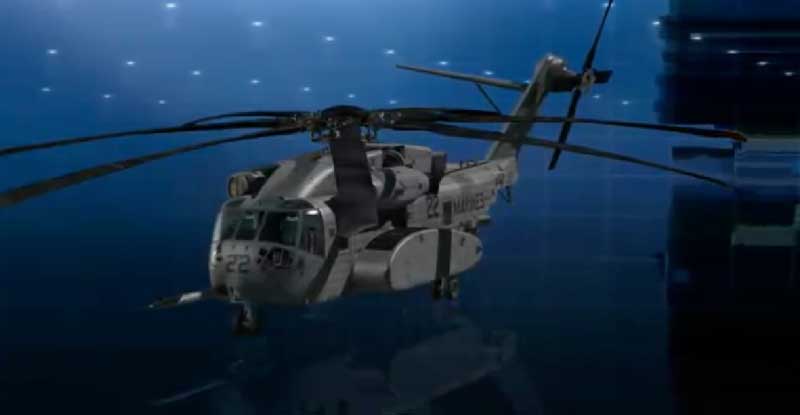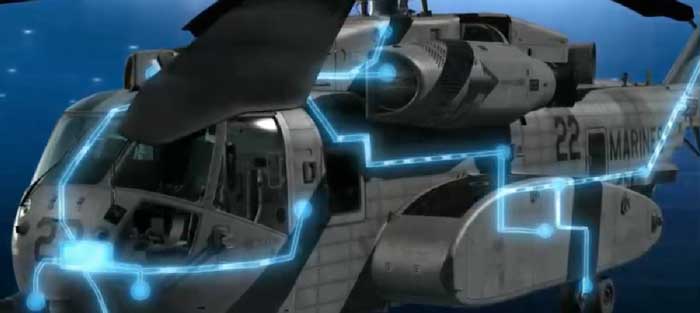Adding a Core USMC Capability: The CH-53K As A Logistical Force Multiplier
An Interview with Major Jeff “Kingpin” Davis
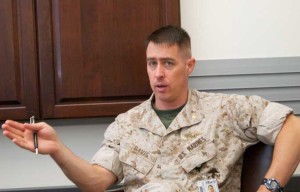
10/16/2010 – The Afghan war and the Iraqi operations have been tough on the rotorcraft supporting US forces. The CH-53E was introduced in 1981 and has been a bedrock USMC asset ever since. But attrition and wear is necessitating its replacement. The CH-53K is building upon the legacy of the CH-53E but is more than a letter change. It is a logistical force multiplier as it carries three times the lift over the CH-53E with the same footprint, and brings significant enhancements as well. And the cost of operations is significantly lower than the CH-53E.
With the addition of the CH-53E to the Osprey and the F-35B, the amphib becomes a whole different animal in the world of USN and USMC operations. We have discussed earlier the changing nature of the amphib and recently the impact of splitting the MEU facilitated by the pairing of the Osprey with the fast jet on the amphib.
In this interview, Major Jeff “Kingpin” Davis of the Headquarters USMC Aviation discusses the impact of the CH-53K for the USMC. “Kingpin” is the APW-51 Heavy Helicopter Requirements Coordinator for HQ USMC Aviation. The video, displayed at the end of this interview, has been provided by Sikorsky and offers an overview of the aircraft and its capabilities.
SLD: How would you describe the need for the CH-53K for the USMC?
Major Davis: I would say from my point of view, the lift piece is a tremendous part of the story. Afghanistan operations right now almost by themselves prove the need for the 53-K. And I say that just because it’s a high altitude, very hot environment, we’ve got IEDs all over the place, so you want to limit the amount of material that you move over the roads.
Right now, the goal is to try to move as much stuff either via C-130, or via 53-Es as you can. If you had a 53-K, you could take three times the amount of stuff in the same distance, and reduce your exposure to road transport.
SLD: The ability to triple the lift allows you to more effective insert force using the Osprey as well?
Major Davis: That is true. If you wanted to put a unit in a battalion reinforced, let’s say, in one period of darkness, V-22 obviously moves the personnel, because that’s what it’s designed to do. The 53-K can bring in the armored vehicles, providing that straight-leg infantry with ground mobility. Now they’ve got vehicles that they can bring in, so now they’re mobile.
You do all that in a single period of darkness, go 100 miles off from the shore into the enemy’s backyard in one night, and you’ve got a battalion reinforced in there with armored vehicles so they can wreak havoc all behind enemy lines.
SLD: Presumably the advantage is either you can do that with less helos or you could have more stuff moved to support the operation?
Major Davis: Yes. When you look at it from a sustainment standpoint, for example, in Afghanistan, you’re looking at sustaining a MEB-sized force within that theatre. I like to consider the 53-K as a real big logistics enabler, because I can take more and do so in higher environment, higher altitude, and environment like Afghanistan.
I like to consider the 53-K as a real big logistics enabler, because I can take more and do so in higher environment, higher altitude, and environment like Afghanistan.
Currently, an Echo can lift a 9 or 10,000-pound load let’s say at 3,000 feet at summertime temperatures right now in Kabul or Bastian. A kilo on the other hand, can take that same load, two and a half, three times, four times the distance. So now, the MEB commander, or the ground force commander, the MAGTF commander, can extend his battle space. His battle space, my opinion, is limited by the logistics that he can push through that battlespace.
SLD: Working in tandem with the Osprey and future F-35Bs, you can provide a tremendous leapfrogging capability for the MAGTF, all being capable of being inserted from the Amphib?
Major Davis: Yes. Absolutely. And when talking about leapfrogging capability, a Yankee and Zulus are going to carry more gas, they’re going to carry more ordnance, because it’s just a much more capable platform. Now the kilo, if those Yankees and Zulus want to go out 100-110 nautical miles, that’s about what they could do. They got about 30 minutes on station time, and they have to come back. You send a kilo out there with it, with a full tank of gas in the back, now you can extend the range of the support you could get out to a couple hundred miles and have them as a gas station, from a kilo aspect.
SLD: Isen’t the opportunity also there because of the high tempo of operations as well?
Major Davis: Yes. To me, the MAGTF is constrained until we get the 53-K out there. There’s only so far you can the MAGTF, because you don’t have the logistical throughput. Once you get a kilo out there, because now you’ve tripled the logistical throughput, essentially over a 53-E, you’ve now got the opportunity to extend the range of the MAGTF. Or at least extend its operating area, for a more dispersed and more distributed environment.
SLD: I assume that it does not make a whole lot of sense to replace the Echoes with Echoes?
Major Davis: There’s no production capacity left for the Echoes. Sikorsky does not have the tooling to go ahead and reproduce the Echo, even if you wanted to nowadays. And you’d just be building an airplane that was designed in the 60’s. That has the reliability and maintainability, the best that we had in the 60’s. The 53-K, just like the V-22 was designed from the start as a survivable platform to operate throughout the battle space. We designed it be able to go where the V-22 could go from a survivability standpoint. Back in the 60’s, we had the vision of the forward line of troops and the Echo would be a logistic hauler and it would never go beyond the forward line of troops. It would never really go into harm’s way. From an armament perspective and from how do we build this to reduce vulnerability, the Echo never had any of that thought process put in. On the other hand, the Kilo, from the ground up has been designed to make the vulnerable area as small as we could possibly make it. How do we build survivability into this platform? We do some modeling and simulation to optimize where you put different lines, where you put the fuel lines, where you put the electric lines. It’s a fly-by-wire aircraft. So a lot less from a control rod aspect, that helps reduce your vulnerability, helps lighten you up, just like the V-22.
The 53-K, just like the V-22 was designed from the start as a survivable platform to operate throughout the battle space. We designed it be able to go where the V-22 could go from a survivability standpoint. Back in the 60’s, we had the vision of the forward line of troops and the Echo would be a logistic hauler and it would never go beyond the forward line of troops. It would never really go into harm’s way. (…) The Kilo, from the ground up has been designed to make the vulnerable area as small as we could possibly make it. How do we build survivability into this platform? We do some modeling and simulation to optimize where you put different lines, where you put the fuel lines, where you put the electric lines. It’s a fly-by-wire aircraft.
So now, it’s that much more survivable from a small arms, from an RPG, from a heavy machine gun type. The 47F was built off of 47-D, which is built off of 47-C, which is built off the 47-A. It’s the 1960s design rolled out even the 1950s design. They just keep remanufacturing and re-adding and putting new engines and new blades and things like that. But you’re never really going to change the survivability of that aircraft — drastically change the survivability of that aircraft unless you completely scrap it, and rebuild it from the ground up, which is the case with the K.
SLD: What are some of the aspects of the design that makes this easier to take care of it?
Major Davis: A couple things; one, a fly-by-wire is going to be a huge enabler. My experience from Iraq in 2006 and 2007, mixing units on the 53-E, where all the flight control rods come in and then they essentially mixes what outputs come from the pilot and goes directly to the main rotor servos and then up. We were going through mixing units: it was crazy. Only because the sand would get in there, and they would erode the metal in the mixing unit, and you would end up getting a lot of play in the mixing unit and that would transfer over to your flight controls, and so the aircraft would get out of rig, and then you would be down.
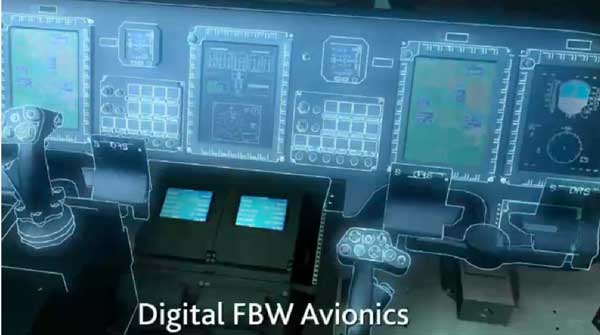
Fly-by-wire, you’re not going to have this problem; you’re going to have a wire that goes from the pilot stick into a computer, and then wires go out and they go to the main rotor servos, you’re going to completely bypass that piece. Another thing we’ve learned over the last 10 years of operating in this environment, engines. The GE T-64 engine is a great engine, but once again, it’s a 1960’s engine. We’ve done some upgrades to it; we’ve put some titanium nitrate coating on the compressor section, for example.
SLD: There is a new engine for the K?
Major Davis: Yes, it is a completely new engine. They’ve taken a lot of the lessons learned from the GE T-64 engine and put it into GE-38. Better titanium nitrate coating; you’ll be able to crack open the engine compressor case while the aircraft is still on wing, as opposed to having to pull it off. You also end up with less moving parts : sixty-four-percent fewer parts on this particular engine. So that’s just from the engine standpoint.
SLD: I assume that there are improvements associated with digital monitoring as well?
Major Davis: We have the IVHMS, integrated vehicle health monitoring systems, on the K. Similar to the same concept as the Osprey has, same concept of the F-35 has, in the idea that the airplane is now going to be the primary driver of tell you when this particular component is failing and providing inputs with regard to what is needed to be fixed as opposed to having a human experience based maintenance schedule.
SLD: I would assume that Sikorsky can leverage their commercial experience here as well with regard to systems monitoring?
Davis: I’m very impressed with Sikorsky. They’re actually doing condition-based maintenance in some respects on their S92 fleet. They’ve got 2,500, I think, S92s across the world. And they have this thing called the FMOC or Fleet Maintenance Operating Center. Every S92 that they own reports home to the FMOC every night. They take that data, and they analyze it and they look for trends. They can make judgments with regard to replacement needs on actual operating experience rather than metrics established simply on guessing or assumptions. So there is an opportunity to blend operations on one side and maintenance on the other, to allow you to fly the helicopter more, and get more operational use out of it.
There is an opportunity to blend operations on one side and maintenance on the other, to allow you to fly the helicopter more, and get more operational use out of it.
SLD: The challenge is to replace the old and pay the price of deploying the new, and over a few short years, the costs saved from deploying the new pay dividends.
Major Davis: Here’s an example. Right now it costs roughly $3,000, a little over $3,000 an hour to operate the drive train portion alone of the 53-E, when you break out the cost per hour and associated costs. The 53-K, based on the last prediction I saw, was about $1,000 an hour for that same drive train piece. So you’ve reduced just that one single area by about a third.
But like you said, you’ve got to pay for that upfront, but when you’re talking about a platform that’s going to be around for 20, 30, 40, 50 years potentially. That saves you big money in the long run.
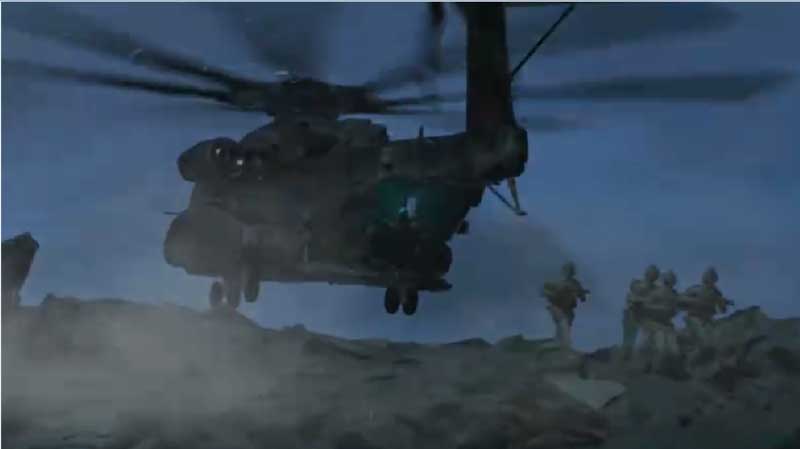
SLD: Could you speak about the impact of having both the Osprey and the K ?
Major Davis: The V-22 brings presence. Because it is designed to take 24 marines a long way and get them pretty quick. The 53-K projects power by providing sustainability.
SLD: When the MAGTF has the Yankees, Ospreys and Ks with the F-35B it has a strong package, which if populated with sensors that can work together will shape a really new and innovative force projection and force mobility package.
Davis: When you talk about the sensor, the mindset shift that people need to get to/get away from is everybody thinks of TACAIR as the guys who are going to make a huge impact on the battle space by themselves. And I’m not saying that they don’t, but the F-35, just like you said, it’s a sensor and it’s that entire communications package that goes with it. Why can’t I have F-35-like communications packages on every platform that I send out? Not just F-35s. We should be replicating that on a V-22, we should be replicating that on a 53-K, we should be replicating that on our UASs. So now, the MAGTF or MEU commander isn’t just limited to getting data from his six F-35s that are out there in the battle space. Anything he flies, anywhere he goes, he’s going to be able to collect that data. Not only to collect that data, but the idea that the V-22s, 53-Ks, F-35s, all share that and get that back to MAGTF, that is a huge capability.
Photos and Video provided by Sikorsky, 2010


